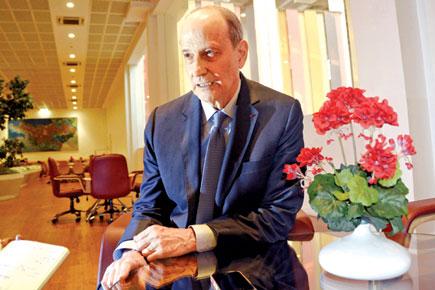How can Mumbai’s libraries be more exciting, inviting and accessible? The former head of New York Public Library, on a city visit, has some advice

Dr Paul LeClerc
The New York Public Library (NYPL), an immaculate Beaux Arts structure with a monumental collection, is one of the best in the world. It even earned its place in Hollywood when the 2004 apocalyptic film, The Day After Tomorrow, showed a few survivors sit huddled by a fireside, fed by books from NYPL.
ADVERTISEMENT
Its most prized possessions include Thomas Jefferson’s autographed copy of the Declaration of Independence, Manet’s illustrations for Poe’s The Raven, and the Gutenberg Bible. Founded in 1895, it has 92 branches across New York, and in the last few decades, has managed a foothold in the virtual world too.

Dr Paul LeClerc, former CEO of New York Public Library, at the Nehru Centre Library. PIC/PRADEEP DHIVAR
Mid-day catches up with Dr Paul LeClerc, who served as CEO and President (1993-2011) of this independently run, and free for the public institution, on a Mumbai visit to deliver a talk at Nehru Centre Library (also free) on the digitization and remaking of NYPL. LeClerc is now the Director of Columbia Global Centers.
To start off, here is a question that’s top on the reader’s mind: Is it the end of the library as we know it?
No. Libraries are certainly changing, but they are used to change. In fact, you could say that of all cultural organisations, even educational ones, libraries have historically been most open to change. So, obviously the change is caused by technology. But if you go back to the origins of libraries, when they began 5,000 years ago in ancient Mesopotamia [the library of Ashurbanipal], they had three basic founding principles – to collect things, to preserve those things, and to let people have access to them. Libraries chose to have very selective collections and they saw themselves as preserving the inscribed legacy of civilizations. Some libraries chose to be open to the public, as this [Nehru Centre Library] is, but a vast majority have chosen to be restrictive in access.
That paradigm remained intact for 5,000 years or so. However, with the information and digital revolutions, these paradigms start shifting. So, what we are dealing with is a global information society that is used to receiving exploding digital-based information, which can be made digitally, or derived from the hard-copy collections of libraries, which can be digitized. So, the question is: Are libraries still necessary? The answer is, sure.
What has NYPL done towards digitization?
In some advanced economies, libraries and institutions got a chance early on to put their collections online. We did that at the NYPL; we were one of the five founding partners with Google [for the Google Books Library Project]. We embraced whole-heartedly the digitization process but, even before that, we did it by digitizing collections ourselves. Our website was created in 1995, and we started building large-scale parts of our collection into an online format in 1997. We decided then not to digitize textual material, but images for the NYPL’s Digital Gallery. We scanned and archived about 7,00,000 images. Four years ago, that image database was being looked at between 10 and 12.5 million times a month. There is immense global appetite for online material.
What according to you are reasons why people still visit libraries?
Libraries should be open because people are coming to libraries in record numbers. There’s one great statistic: In a given year in New York City, more people go to libraries than they do to sports events, all the museums, zoos and parks. Last year, there were 37 billion visits, which is astonishing. If you have libraries open every day and if you had services that people needed, then people will keep visiting. But if you are not in New York, and you need to access the library’s content, you can do that through ever-increasing modes. What we noticed when we digitized material was that they tend to be used more, especially the research collections.
How would you lure the average reader into a library?
One observation is that if you digitize your materials, that makes people discover what you have, and that then drives traffic to see the actual object. Libraries with huge collections, such as the NYPL, are at par with the British Library and the French National Library, or the library at Harvard University. These have about 70 million objects, and usually, only a quarter of these are books. The rest are manuscripts, photographs or maps. So, one of the ways you can draw people to the library is by putting on display – not just the treasures of the library but the things that people wouldn’t believe are necessarily part of the library — and see them react, ‘Oh my God! I didn’t know they had that!’ Our curators made a decision once that they wanted the social history of the AIDS epidemic to be written as part of the library’s collection. So they started collecting vast amounts of material. When you let people know what you have – and you can do that digitially – for free, people come to you for those things.
So, digitization need not just mean the transfer of text from hard copies. It also means making it more interactive and engaging the curiosity of online visitors.
Yes. You can do that through, for example, crowd-sourcing. For instance, NYPL has a great collection of menus. Thousands, many thousands of them from the 19th century, many of them from working class people. There was no way the library staff could do anything with these menus other than create some sort of inventory. They very cleverly decided to crowd-source menus. If you wanted to join this effort, you could enter different kinds of things that are on the menu and contribute to this general database. And people love to do that! It was not a history of the elites, what they wore or purchased. It was a different kind of historical analysis.
Is a search engine like Google a competition or a resource for libraries?
Well, you ask a librarian something and the first place s/he is going to go is Google. It’s the first effort. The Google Books Project represents 7.5 billion pages. It’s gigantic, it’s fabulous. But these are just books. There are other things that a library has – like photographs. Over time, these are discoverable through Google but are not part of the Google Book archive.
Once a library becomes virtual, what becomes of the actual structure, the physical space?
Every afternoon in New York City, at least 1,00,000 children visit libraries after school. These latchkey children go the library until they are picked up by their parents after work. We want libraries to become community spaces. We want people to be present [inside]. We want senior citizens to be there, rather than at home, alone. Librarians have all kinds of activities, like book groups, special teen spaces with soundproofing to play music and so on, for free.
There is also the ‘Ask NYPL’ service. If you need information that you can’t find yourself, then you can just call a toll-free number and get advice. It could be – How to get a green card? Where can I find tax forms? We found out that people needed help finding a job. So, we had a service called Job Search. Barack Obama was a graduate of Columbia College, went to the NYPL for help in finding a job as a community activist in Chicago. One of our librarians gave him a printed book with all the places he should write to. Once, jobs were listed in newspapers; now it’s online. We do that today not with printed volumes of job places but by helping people search online by teaching basic computing skills. Librarians are human search engines.
Did you library that?
A couple of weeks back, the NYPL stumbled across a box of queries from the 1940s through the 1980s that were put to its librarians. These have been posted on Instagram since. The questions include: What kind of an apple did Eve eat? What was the origin of bedsheets? Any statistics on the life span of the abandoned woman? Many of the questions will flummox you, but the NYPL librarians have answered these patiently, it seems. The service, which was once meant for customers in person or over calls, is still available, as ‘Ask NYPL’, online and over a toll-free number.
Check out: nypl and #letmelibrarianthatforyou on Instagram
 Subscribe today by clicking the link and stay updated with the latest news!" Click here!
Subscribe today by clicking the link and stay updated with the latest news!" Click here!






